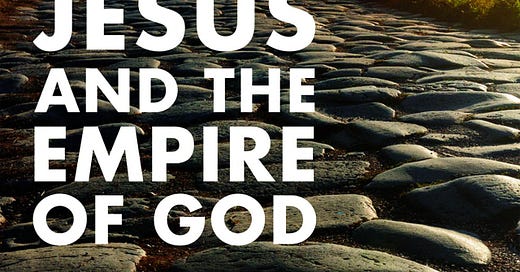Book Review: Jesus and the Empire of God
Two quick notes; First, I received this book for free from Speakeasy, in exchange for my candid review. Secondly, the author of this book is Dr. Warren Carter, who was my New Testament Professor in 2016.
Interpretation is a difficult task, particularly if one is interpreting a text written in a different language and written, edited, and compiled thousands of years ago. When one is interpreting a text that many consider to be Scripture, the stakes are even higher. It is tempting to simply want to superimpose our current context onto the Biblical text and ignore the actual socio-political context.
However, doing so, at best can lead to us missing valuable and important information that gospels may be trying to convey and at worst, can contribute to harmful and oppressive interpretations. It is vitally important that those who take Scripture seriously have some knowledge of the socio-political context of the text. It would be great if everyone had the interest and the financial resources to attend seminary and engage in a deep study of the Biblical text, but that is not possible. However, there are accessible books that can help illuminate our understanding of scripture and the context it was written in.
One such book is Jesus and The Empire of God: Reading the Gospels in the Roman Empire, written by Dr. Warren Carter. Dr. Carter has a Ph.D. in New Testament from Princeton Theological Seminary. He is currently Meinders Professor of New Testament at Phillips Theological Seminary.
In Jesus and the Empire of God, Carter utilizes a “cultural intertextuality” approach to examining the gospel. He explains that this approach, “places texts into relationship with other texts to create meaning.” (3).
Carter is exploring the Gospels in light of specific Roman imperial texts from the 1st and 2nd centuries of the Common Era. Carter also expands the definition of text to include not only written documentation but also monuments, buildings, statues, and coins.
It is important to note that cultural intertextuality is NOT stating that one text was directly sourced or derived from another, “but it does recognize that texts from quite different communities and traditions participate in various ways in common cultural contexts and interact with various other texts.” (3)
The Gospels, like any written text, are not written in a vacuum. There are cultural and political interactions that occurred in the writing and compiling of the Gospels, that many of us in the 21st century can easily miss if we only insist on imposing our 21st-century context on the text or if we seek to spiritualize the text and divorce it from any context.
This is not to say that the Gospels and cultural intertextuality do not have any relevance for those living today. Dr. Carter makes it explicitly clear that this engagement in cultural intertextualities is not simply a practice in understanding ancient history but also a reflection of his socio-political location and his engagement with modern-day empires. He explains that exploring the intertextuality of the gospels and of imperial literature can help us think critically about empire and the ways in which power and privilege operate today.
Before delving into examining specific texts, Carter provides a brief background on the basics of the Roman Empire: including population, geography, social hierarchy, sources of wealth and power, etc. His explanations are accessible and also short, providing readers the necessary background information without getting bogged down in details.
Understanding the ways in which the gospels follow standard Roman Imperial literature and differs from it is also helpful in advancing the discussion of the Biblical text beyond what is “literal factual and true.” Instead of asking, well is the genealogy provided in Matthew “truly accurate” or is the virgin birth a literal, historical fact, it is much more useful to ask, ‘what were the authors trying to signal about God and Jesus via this story.”
By exploring how Roman literature often employed genealogies, divine origin, and adoption by God to help establish the authority of the emperor and the ways in which the gospels utilized similar devices to describe the origins of Jesus, but did so in a way that challenged rather than reinforced the power and authority of the Roman Empire, one can move beyond questions of literalness and apologetics and focus on why Jesus was a threat to the empire.
The book in general is extremely accessible and understandable. I can imagine professors assigning this text to their undergraduate and MDiv students, however, its audience need not be limited to academia. Adult Bible studies and book studies will find the information in this book vitally important and yet accessible.
It does help to have a general understanding of what the gospels say (and Carter does provide citations for specific passages) but one need not be in an undergraduate or graduate program to find this book useful and illuminating.



